Practical Effects of The Thing
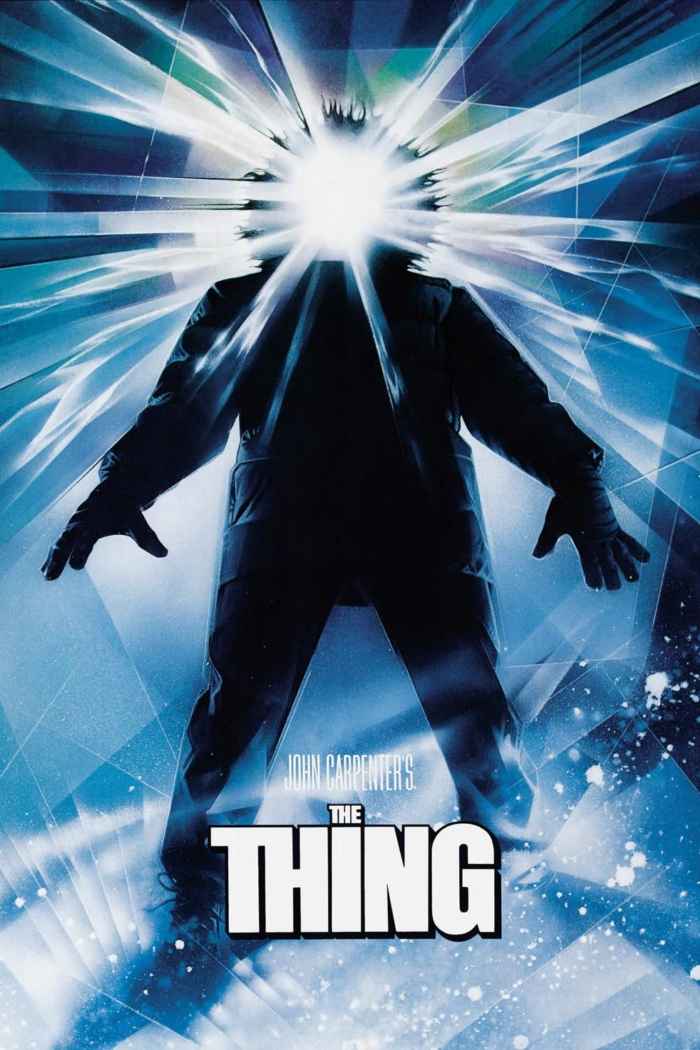
In 1982, Computer generated effects were still very rough. They could perform basic functions, but their integration and interaction with the real world had not yet evolved to a point of believability. It would not be until over a decade later that technology became advanced enough to hide these effects. This advancement also continuously shows the age of effects from years prior. Movies would look out of date and cheesy only a few years later. Instead, practical effects were the standard for special effects in film since its creation. Because they were real, they didn’t have to hide like CGI images. They could act and react in a real space. Costumes, makeup, and miniatures are only a few of the tricks that talented artists use to bring the fantastic creations to life.
Star Wars spawned ILM, an entire effects company due to its immense overload of effects including everything from stop-motion to elaborate costumes. In An American Werewolf in London, Rick Baker used various animatronics and makeup techniques to portray the dreadful transformation of a man into a deformed beast. However, it was Bakers assistant, Special effects creator Rob Bottin and his work on The Thing, who created effects so palpably gut-wrenching that they make audiences shudder to this day.The 23-year-old artist endured painstaking hours; working 7 days a week for 56 weeks. After the film’s completion he checked himself into the hospital for exhaustion. The result of his tireless work was an innovative alien horror that matched director John Carpenter’s eccentric taste for the grotesque.
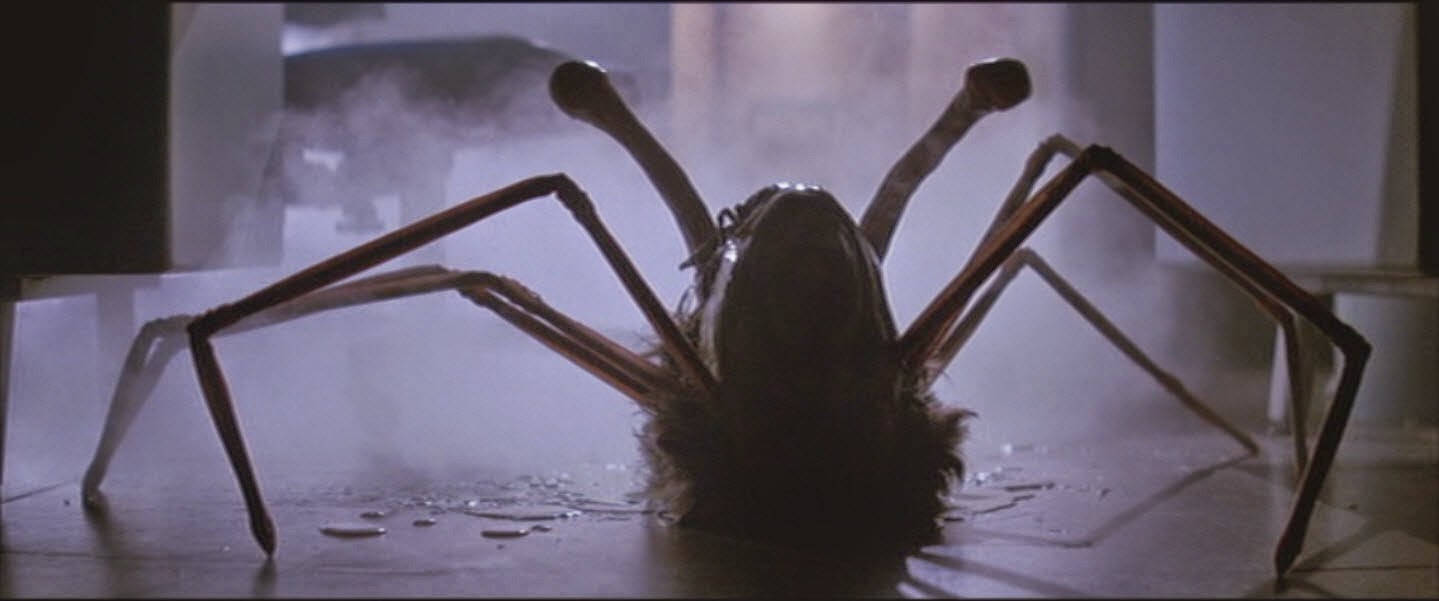
“Because what I didn’t want to end up with in this movie was a guy in a suit. See I grew up as a kid watching science fiction and monster movies and it was always a guy in a suit…and my fear was ‘they’ll laugh at us’. So when I saw that stuff coming out [the effects] I was like ‘phew’”.
-John Carpenter (source of all quotes)
Carpenter’s iteration is a world away from its predecessor The Thing From Another World (1951). Practical effects of this complexity weren’t possible. The thing was a veggie-Frankenstein that was killed when the scientists electrocuted it. Exactly what the director didn’t want to put on screen. Carpenter and Bottin created a monster that has no form. The sheer number of effects create an ever-changing monstrosity. It more closely resembles its source material, John W Campbell’s novella Who Goes There? Each individual cell is like its own creature. Constantly mimicking to stay alive. Bottin created various moulds and statues off the bat to immediately set his vision the thing’s amorphous appearance.
“Robert already started sculpting a lot of the things like he sculpted the fused bodies…and that was lying on the floor when I went by for the first time and I just remember thinking ‘this is an amazing, grotesque art’”.
-Richard Masur
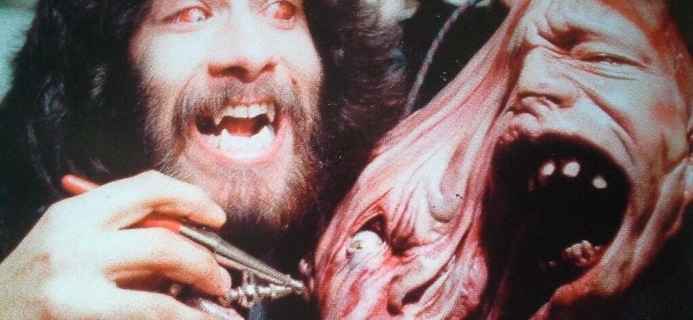
His creations included use of everything under the sun. Mayo, Strawberry jam, foam latex and KY jelly being just a few of the ingredients that made the monster palpably sickening. The smorgasbord of gooey accoutrements that compliments Bottin’s strange creations, helped bring the nebulous monster to life. Bottin didn’t work alone, however. At one point he was so beleaguered by the sheer number of effects that he called on friend and fellow SFX creator Sam Winston to create the thing-dog hybrid that first introduces the audience to the horror they are in store for. An impressive sequence, Winston pulled no punches in creating a form that seemed to be constantly evolving, as the monster unfolded into an unrecognizable mass of eyeballs and tentacles. Winston would pilot the aliens head with his arm in an extremely elaborate puppet while other crew members would also operate various moving parts of the writhing alien beast. The team used reverse shots to obtain certain effects, meaning rubber tentacle like hoses were pulled through the alien model; the footage was then reversed creating the effect of gruesome appendages growing from the thing. The scene built up to the only reasonable conclusion, with Keith David dousing the monster with a real fully functioning flamethrower.
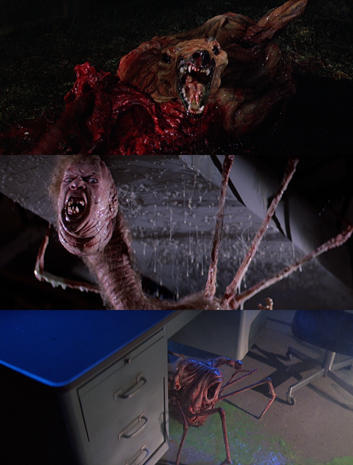
The true appeal of The Thing is that the monster truly has no form. It morphs and imitates constantly. It can become any living thing. Assume its mannerisms. Its memories. Its form entirely. Having many changing variations of effect was the obvious consequence of this. Scenes featuring the monster required intricate rigs that splinter off to reveal entirely new horrors.
In one particular scene, Norris (Charles Hallahan), collapses due to an apparent heart condition. Already in a panicked state his fellow survivors rush him to the doctor who begins defibrillation. Norris’ torso suddenly opens to reveal a monstrous chasm as the doctor goes in for another compression. His arms are bitten and ripped off by the thing. As the other men rush in to assist, the thing’s chest erupts in a green meaty explosion. A spider like creature with Norris’ deformed visage clings to the ceiling vent. As The men subdue the parasitic-like abomination with the flamethrower, Norris’ original head stretches and tears at the seams from his body. It falls to the floor before sprouting more spider-like legs and retreating.
This scene is hard enough to follow with the imagination. Now picture having to create every effect in gory splendor. A process with 3 separate monsters and even more rigs. Hallahan spent 10 days with Bottin to create a complete and lifelike mould of the actor to house the hydraulic jaws that would serve as the mouth. It was so realistic that Bottin even matched Hallahan’s chest hair pattern.
“The day we shot the sequence of my chest exploding I was inside the examining table… It was really my head, my neck, my shoulders, and my arms. Everything else was the model. Richard Dysart came in that morning when I was already in the harness and he said ‘put some clothes on that guy, for god sake’ and it wasn’t until he was right on top of me that he realized that it was fake. I’m shocked how accurate it is.”
– Charles Hallahan
The next problem was how to show the doctor’s arms being ripped off. Well instead of filming the doctor and the effect in completely different shots, the team affixed fake arms to a double amputee. They made a hyper realistic mask of Richard Dysart (Dr. Cooper), knowing that in all the chaos the audience would never notice that it was not the real actor. Again, the mask was so well-done that co-stars first believed that production had simply found a body double amputee that looked exactly like Dysart. Bottin’s work was so impressive that it was freeing the team to different shooting possibilities.
The chest eruption shot was a whole other kind of beast. The single shot took up an entire shoot day given its difficult setup and reset time, with each setup taking 10 hours. I say each because although the shot was meant to be done in one take, Carpenter thought the first take looked too much like a fountain. Bottin luckily secured the take the second time around but this just goes to show how delicate a procedure each effect was, especially considering how important the effects were to set the tone of the film. The following sequence in which Norris’ head frantically tears from his body was no different. With melted chemicals and bubble-gum in place to create the effect of alien innards, the crew readied themselves within a small room filling with toxic fumes (nobody said practical effects were always health conscious). “We actually had this goo that we would pile in there really quick. And the whole time its giving off fumes like paint thinner, and lacquer thinner and all this kinda stuff” Bottin said of this effect. Not the best environment to be breathing in.
There was another problem however, as this concoction also produced flammable gases. And when Carpenter stated that he needed fire effects for continuity, the entire body mould and effect went up in flames. Once again, in order to produce a shot that would appear on screen for no more than 5 seconds, Bottin and the team had to undergo a full day reset.In order to turn the then decapitated Norris into a spider monster, Bottin created legs that would be pulled through the head into the floor and then reversed, similar to earlier shots in the dog kennel. The illusion of movement was created by then putting the head on a remote-control vehicle and piloting it while a different set of legs (this time animatronic), created the illusion that the creature was scurrying away. The effects that comprised this scene took Bottin months of tireless, grueling work. In the end, they were on screen for under 3 minutes.
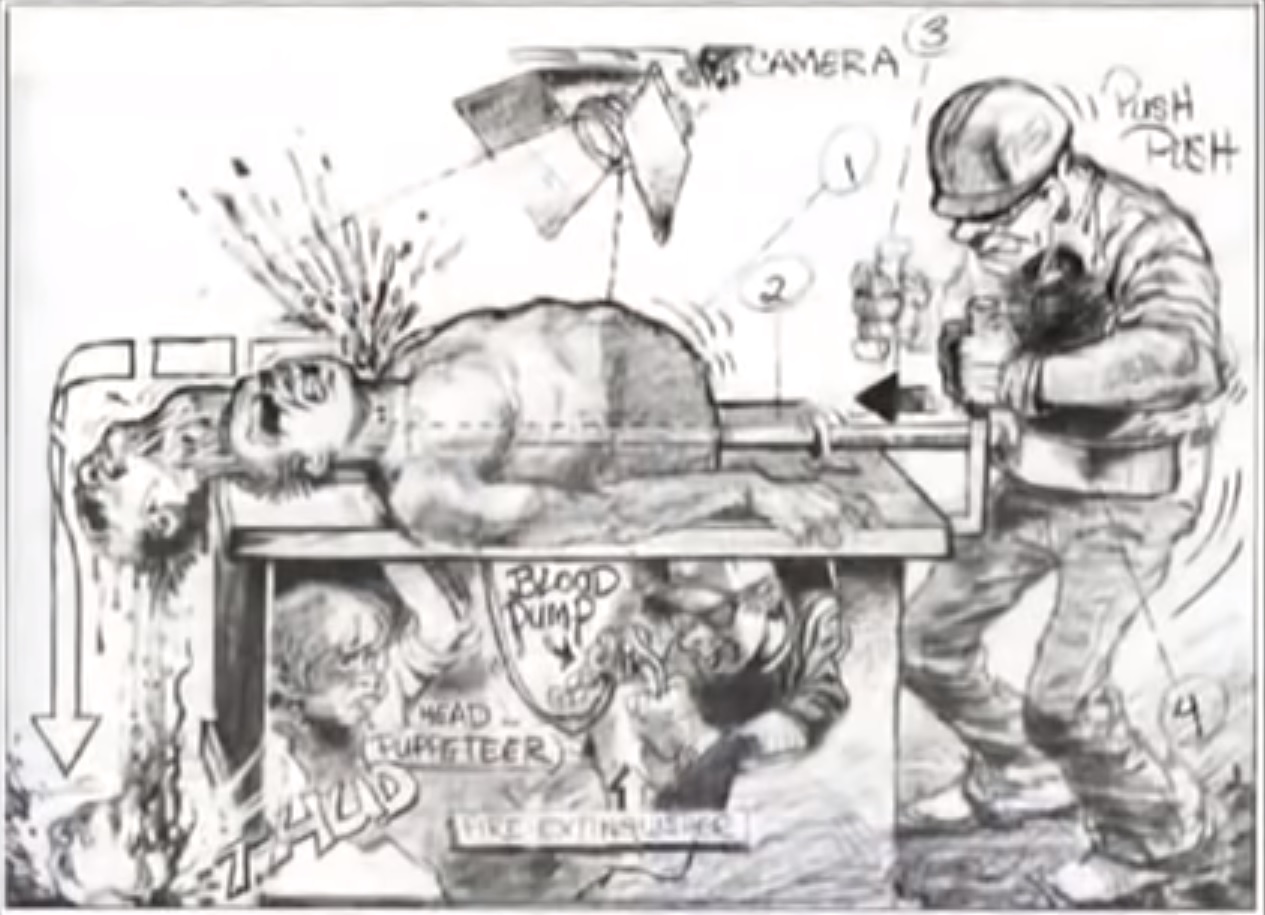
Time-consuming and meticulous, but the care makes all the difference. The fact that somebody took the time to make each and every effect by hand that still inspire horror 37 years later. Effects artists and companies (CGI included) are overlooked and undervalued. In the last few decades, the saturation of patch-work, after-the-fact effects have become a substitute for meaningful effect contributions. We as film-goers have become so beset by computer effects, that seeing real tangible effects is becoming a rarity, and many audiences fail to notice. Because the effects are supposed to hide in plain sight, they incredible work of the talented men and women who make them has become widely overlooked by Hollywood. Green screens have become the indistry norm. It’s a refreshing reminder when looking back on feats like Bottin’s effects that real blood, sweat, and tears will always have a place in film.
What do you think? Leave a comment.











I really enjoyed reading about the practical effects used in The Thing and other films! It highlights the creativity and ingenuity of the production and design team!
I always have enjoyed watching The Thing. With the 1982 and 2011 versions add in The Thing From Another Planet (1951), we can probably expect more to come.
For me a rubber head looks more real than a well modeled CGI head simply because it has a real basis in reality. It’s really there in the room with them, rather than over layed at a later date.
Up there with my other fav horror movies Alien and Halloween.
Amazing article. The Thing was seminal as it used no CGI, used Bottin’s great imagination and has a good story at the heart of it to back it up, very few films today, if any, care about narrative, the paranoia and the disintegration that the Thing brings to the camp is the crux of the story, great characters as well, that’s why it is a classic.
I really, really love The Thing. Great choice of topic.
When John Carpenter had it, he really had it. Shame he lost it around the time of “in the mouths of madness”
I was about 11 or 12 when I first saw it, and Palmer’s line when he sees that the severed head has grown legs – “You’ve got to be fucking kidding” made me laugh out loud. Which takes some doing when you’re rooted to the spot with fear.
I watched it on video a couple of years after cinema release. My wife had let in a stray kitten to feed and shelter the same day. The kitten stared at me throughout the whole movie. It didn’t stay the night.
My favorite horror. First saw it on VHS on a 10″ portable tv, at lunchtime bunking off from school in 1984 as a 12 year old. Scared the hell out of me.
Yes yes yes! An absolutely fantastic movie. Well described! The irresistible quivering dissolution of human beings in it has never been surpassed for horror. Great job all round!
A great article. Ah, the days of in-house and in-camera special effects. We won’t see their like anymore. Maybe I’m just old school, but I love the power of imagination, rather than having everthing handed to the viewer on a plate. Ok, we knew the effects were a bit ropey in places, but what the hell! Great fun.
Great discussion! Really amazing the artistry of real special effects and great to see that some shows and films still utilise this rather than CGI and boy the difference is really visceral.
The chest-chomp scene caused me to burst into tears from fright when I first saw the film on the TV, aged about 11 or 12. Seriously sick film – and a great treat for horror fans.
I’m really not sure that The Thing is the masterpiece of tension and paranoia that people think it is. I watched it the other day, and I think the problem is that all the characters are too similar and ill-defined to really stand out, apart from Kurt Russell’s gruff and manly turn as MacReady.
Essentially The Thing is a film about a man’s head coming off and turning into a big spider. It’s like the filmmakers thought of that first and went from there.
The ability of Carpenter (or the handlers) to make a dog’s movement and behaviour so sinister is what sets this movie apart from other sci-fi horrors. The way it slowly walks down corridors, looks around doorways and finally settles in the pen still unnerves me. Chilling stuff.
This movie is what cinema was invented for! Spectacular entertainment as artful as it is populist. A perfect film.
Great analysis. It’s good to remember what made this film great now that the ‘prequel’ is out. It reminds us once again what’s wrong with modern films. The director of the new film has tried so hard and reverentially to join up the loose ends to the original he’s forgotten what made the first one so good. I couldn’t remember any of the characters’ names, not even the heroin, just someone called Lars, whose name they kept shouting. Also the CGI effects are just too smooth and tidy and have none of the visceral messiness of the original creature.
Only watched this again last week coincidentally. Still has a great atmosphere of menace. Love the setting. The music Carpenter used in those early films – Assault on… Halloween – helps. Only gripe, although I like the opening helicopter pursuit scene it’s slightly ruined by the pitiful attempts of the Norwegians (?) trying to kill the dog.
Last time I watched it, it just seemed interminably slow it hasn’t aged at all well.
Wine is not for everyone.
Carpenter’s eye, a perfectly executed genre script, underplayed performances of madness and real, tactile effects make for one of the absolute gems of American cinema.
I don’t usually watch extras on DVDs – why the hell would I wanna know how it was done? That sort of thing spoils the magic, as far as I’m concerned.
The Thing is a rare exception. Bottin’s effects, the camaraderie of the group – all of the extras are worth a watch. Particularly if you’ve watched the film about a hundred times…
This is a fascinating view on a world before the blessing\curse of CGI. Where guys built stuff rather than programming it. Built it, covered it in goo, then plunged it in gloom and partially lit it through a slat in the fence. Brilliant.
I love The Thing. It’s one of those films I can’t wait to show my kids. Mind you, the eldest had nightmares watching Donnie Darko recently so it can wait…
Have watched it twice and the last time very recently.
To be honest I find it rather flat. There’s an abundance of acting talent on board and no one really looks desperately involved. Kurt Russel’s antihero seems to have been numbed by the booze he has a thirst for.
Yes the effects are class as you outlined in the article, but not scarey or desperately menacing.
The notion that you could be the creature without conciously knowing it was terrifying in a very disturbing way.
The effects are all the more impressive when you realise that it’s all done with lumps of rubber and mechanical devices. Without a blue screen in sight!
I enjoyed learning about the development of special effects in movies and its evolution over time. Prime examples used.
A real ground-breaker in terms of special effects.
I really recommend Peter Watts’ most excellent “The Things” short story. If you like the film, you should feel obliged to find it and read it.
I guess the advance of CGI has destroyed the demand for effects specialists like Bottin.
Hi James, great piece on The Thing and practical effects, I’m often citing the film as evidence for a PE renaissance.
I’m a huge fan and, like many others, felt let down by the prequel. I bet a sibling article comparing the two would be a cool idea, highlighting the modern trope of frenetic, in-the-trenches camerawork as a tool to blur CGI.
Excellent article and choice of film.
The Thing proves just how much CGI takes the life out of films.
I think it’s very important to see how filmmakers did things before they could jus do anything. Creativity comes from working with limitations. How do I make what I want to make with the resources I have. Once you get the element of CGI into the process, you have to figure out how to use it as an additional tool rather than the core of the work.
I appreciate the detail you went into when discussing the effects and the history of the movie. One small thing—the effects person Carpenter worked with was Stan Wilson, who I believe also directed Pumpkinhead!
John Carpenter in one of the few directors whose films I never feel I have to ‘read into’ or look for hidden meanings in. That doesn’t mean they’re not there it’s just that the filmmaking is always so engaging on a surface level that it’s satisfying enough in itself.
Films by John Carpenter have always been campy fun. I remember enjoying ‘Christine’ too. ‘The Thing’ has one of the most iconic scores among horror films.
It’s an amazing accomplishment has proven will stand the test of time
This article while enjoyable as it may be for the casual reader…
It’s FILLED with many old errors, publicity hype, and erroneous hand-me-down legends from the internet. I’d love to see someone do more than just Google search for “Rob Bottin and The Thing” to come up with an article!
Stan Winston’s contribution is blown waaay out of proportion, and the strawberry jam, mayonnaise, bubblegum bit still cracks me up after all these years!
This stuff is so old and worn out after 40 years, it’s an inside joke, that nobody gets… I know, because I worked on the original movie creature effects.